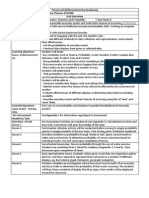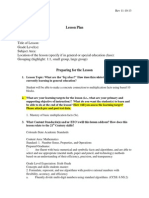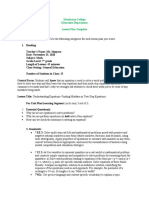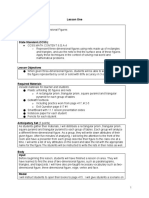Lesson Plan Chance 1
Lesson Plan Chance 1
Uploaded by
api-287776211Copyright:
Available Formats
Lesson Plan Chance 1
Lesson Plan Chance 1
Uploaded by
api-287776211Original Title
Copyright
Available Formats
Share this document
Did you find this document useful?
Is this content inappropriate?
Copyright:
Available Formats
Lesson Plan Chance 1
Lesson Plan Chance 1
Uploaded by
api-287776211Copyright:
Available Formats
Practicum Lesson Number
VEL Strand Discipline Based Learning
Date
Topic and Focus Mathematics Chance/Probability
Year Level Grade 5/6
Time of Lesson
Duration of Lesson 45 Minutes
Class Size 25
Student Learning Objectives and relevant Aus Curric/AusVELS/N
Syllabus
outcomes:
In this lesson students will be introduced to chance. They will be expose
the
vocabulary associated with chance and will be encouraged to used these
words in
their explanations. Students will learn that probability and chance are on
continuum
from 0 to 1. They will be expected to participate in experiments and rec
data; they
will use the data to make judgements about chance and probability.
AUSVELS:
Grade five students (by the end of the unit) will be able to pose questions to gather data and constru
various displays
appropriate for the data, with and without the use of digital technology. They compare and interpret d
data sets.
Students list outcomes of chance experiments with equally likely outcomes and assign probabilities a
number from 0 to 1.
Grade six students (by the end of the unit) will be able to interpret and compare a variety of data dis
including
displays for two categorical variables. They analyse and evaluate data from secondary sources. Stud
compare observed
and expected frequencies of events, including those where outcomes of trials are generated with the
digital
technology. They specify, list and communicate probabilities of events using simple ratios, fractions,
and
percentages.
Recognise that probabilities range from 0 to 1 (ACMSP117)
Compare observed frequencies across experiments with expected frequencies (ACM
Assessment/Means of Evaluation and Method Used
Student learning will be identified through the experiments and activities explored in
classroom.
Students will also need to show they are able to use the correct terms in conversatio
about their
work. Student work will be collected and analysed for student understanding of and
confidence with
chance and probability.
Student Teacher Focus
Classroom Management: Ensuring students are not disrupting each other while the
explanation and
on task learning is occurring. Giving assistance to those who require it. Keeping cla
noise at
moderate to low levels.
Lesson Flow: Being able to get the class attention and focus them on the new aspec
lesson.
Moving from introduction to activity to explanation to activity and then packing them
well.
Making all the parts make sense to the students using the right terminology to let
connect
their experiments with the explanation. (connecting recognise that probabilities ran
from 0 to 1
(ACMSP117) with compare observed frequencies across experiments with
expected frequencies
(ACMSP146))
Students Background Knowledge
Students are able to solve number problems using mental and technological method
Students have an understanding of how to graph data and how to read graphs.
Students have learned about percentage, decimals and fractions. They understand h
interchange
fractions into decimals and percentages. Students are able to compare, order and
represent decimals.
These skills will be necessary in the unit on statistics and probability. Students will n
revisit
number and learn how chance is represented on a number line. They will need to
understand that
probability is connected to number as well as percentage and be able to represent t
findings as a
fraction, decimal or percentage of a whole.
Resources and Materials
Maths project books.
Number line and vocabulary worksheet.
Rock-paper-scissors worksheet.
2
Students will be completing the vocabulary worksheet on their own to familiarise
themselves with the
language and ideas in chance.
Students will complete a paired activity scissors, paper, rock. They will tally up how
times each person won out of 18 games.
Results will be analysed on the board. Discussion about fairness and how many poss
the game
has for player A to win and player B to win. Is it a fair game? Does each player have
opportunity
to win a round?
Classroom Organisation
Students will work in pairs for the rock-paper-scissors activity (they will fill out their own she
glue into their
maths project book).
Students will work individually on the cutting and gluing activity.
Lesson Plan
5/10 Mins
Stage
1)
Introduction
Using a di ask the students who has used one to play a
board
game before?
Is it possible to make the dice land on the side they want?
legally?
How likely would it be to roll a 2?
How likely would it be to roll a 6? etc
(Explain that it would be a 1/6 chance or there is some
chance.)
*Go over it as long as the kids need it*
5 Mins
20 Mins
2) Explanation of Task
Explain the cutting and gluing task ask them if they
understand
the number line? 0-1.
Also explain the paper-scissors-rock activity briefly. Once ther
are
a few students done, explain it again in more detail answer
their
questions.
3) Students on Task
Students should be cutting and gluing the vocabulary onto th
number line into their maths project books. They need to be
confident in using the terms in a sentence.
5 Mins
5 Mins
Students who have completed that task move onto the paper
scissors-rock activity with a partner. They both need to fill out
their
table of results.
Once they have completed the game, there are three
questions to
direct them to complete.
4) Conclusion
Ask the students how many games they had played, how
many had
they won?
Also ask them to share their score as a fraction.
What did they learn from their activities?
5) Closure
Pack up the scissors and glue and also throw out any scrap
paper.
Put away maths books.
Reflection on Student Learning
What did you observe about student learning?
Comments on Future Lesson Directions
Are there areas you need to go over or move beyond?
Reflection on Lesson
How was the timing or the flow of the lesson? What other observations did you make
Reflection on Student Teacher Outcomes
Did you meet your own focus objectives? Could you still improve in that area? Were there
other areas
you feel you could concentrate on in the future? What were the positive points of your
lesson?
Supervisor Evaluation
You might also like
- g4 Area and Perimeter UnitDocument20 pagesg4 Area and Perimeter Unitapi-249159678No ratings yet
- Udl Lesson Plan - Ed 4702Document6 pagesUdl Lesson Plan - Ed 4702api-242345831No ratings yet
- Lesson Plan On Integers For 7th GradeDocument3 pagesLesson Plan On Integers For 7th Gradeapi-302273321No ratings yet
- Lesson 5-Using Similar TrianglesDocument4 pagesLesson 5-Using Similar Trianglesapi-269787508No ratings yet
- (Complete Answers in Purple Font) : STEM 433/533 Lesson Planning TemplateDocument4 pages(Complete Answers in Purple Font) : STEM 433/533 Lesson Planning Templateapi-535160423100% (1)
- Grade 4 Multiplication Lesson Plan OduDocument5 pagesGrade 4 Multiplication Lesson Plan Oduapi-510272133No ratings yet
- Udl Math LessonDocument8 pagesUdl Math Lessonapi-273177580100% (1)
- Chance Lesson 3Document5 pagesChance Lesson 3api-287776211No ratings yet
- Matilda Tiered Lesson PlanDocument22 pagesMatilda Tiered Lesson Planapi-515156352No ratings yet
- 5E Planner For Learning in Science and Maths Context For LearningDocument15 pages5E Planner For Learning in Science and Maths Context For Learningapi-526103844No ratings yet
- Mathlessonplan Perimeter AreaDocument8 pagesMathlessonplan Perimeter Areaapi-316754926No ratings yet
- Fractions, Ratios, & Decimals Are Amazing!Document13 pagesFractions, Ratios, & Decimals Are Amazing!Annmarie McGonagleNo ratings yet
- Measurement Unit PlanDocument5 pagesMeasurement Unit Planapi-443252259No ratings yet
- Task 4 - Planning Lessons For Teaching MathsDocument11 pagesTask 4 - Planning Lessons For Teaching MathsWinston Alexander100% (1)
- Edfx 213 Chance Lesson Plan With FeedbackDocument6 pagesEdfx 213 Chance Lesson Plan With Feedbackapi-265545872No ratings yet
- Math Lesson Plan 11-24-14Document13 pagesMath Lesson Plan 11-24-14api-271087867No ratings yet
- Math Lesson PerimiterDocument6 pagesMath Lesson Perimiterapi-340404014No ratings yet
- Lesson Plan Course Name: College and Career Readiness: MathematicsDocument3 pagesLesson Plan Course Name: College and Career Readiness: Mathematicsapi-292046485No ratings yet
- Year 5 t1 Unit 6Document10 pagesYear 5 t1 Unit 6api-267136654No ratings yet
- Unit Plan For Probability: Key To Resources in This DocumentDocument6 pagesUnit Plan For Probability: Key To Resources in This Documentapi-332722181No ratings yet
- Maths 4 Lesson SequenceDocument9 pagesMaths 4 Lesson Sequenceapi-403288944No ratings yet
- Tiered Lesson Plan and AppendiciesDocument7 pagesTiered Lesson Plan and Appendiciesapi-295583127No ratings yet
- Variability in Sample Proportion. The Idea of Sampling Distribution Will Be Extended From TheDocument3 pagesVariability in Sample Proportion. The Idea of Sampling Distribution Will Be Extended From Theapi-435318918No ratings yet
- Lessonplan 4Document5 pagesLessonplan 4api-311997397No ratings yet
- Observation M Grammer 3-2-16Document3 pagesObservation M Grammer 3-2-16api-310422729No ratings yet
- Voulme Lesson 1Document4 pagesVoulme Lesson 1api-330599039No ratings yet
- Lesson Plan 1Document8 pagesLesson Plan 1api-319277310No ratings yet
- MathlessonplanDocument13 pagesMathlessonplanapi-252974940No ratings yet
- Lesson Planning Form For Accessible Instruction - Calvin College Education ProgramDocument4 pagesLesson Planning Form For Accessible Instruction - Calvin College Education Programapi-336528722No ratings yet
- Normalcurvelessonplanweek 2 ThursdayDocument3 pagesNormalcurvelessonplanweek 2 ThursdayDarwin MacaraegNo ratings yet
- Lesson PlanDocument5 pagesLesson Planapi-312746437No ratings yet
- Day 3Document3 pagesDay 3api-240598413No ratings yet
- Lesson Plan 2Document5 pagesLesson Plan 2api-341104695No ratings yet
- Lesson 2 Perimeter and Area in The Coordinate PlaneDocument3 pagesLesson 2 Perimeter and Area in The Coordinate Planeapi-283338157No ratings yet
- Ubd Planning Template With QuestionsDocument3 pagesUbd Planning Template With Questionsapi-217297849No ratings yet
- Interpretingdata Grade6 Edf3021 Mathsassignment2Document5 pagesInterpretingdata Grade6 Edf3021 Mathsassignment2api-320610068No ratings yet
- Probability Lesson Plan - 5E Instructional Model: Cassie GreenDocument3 pagesProbability Lesson Plan - 5E Instructional Model: Cassie Greenapi-482582979No ratings yet
- 1-Scoe Lesson Planning Template Fa23 1 2Document5 pages1-Scoe Lesson Planning Template Fa23 1 2api-583052012No ratings yet
- Scatter Plot Lesson PlanDocument8 pagesScatter Plot Lesson Planapi-254064000No ratings yet
- 3c. Prove Theorems About Parallelograms Lesson PlanDocument2 pages3c. Prove Theorems About Parallelograms Lesson PlanDhingcoi Czc Allado AducalNo ratings yet
- Lesson 1Document4 pagesLesson 1api-270322298No ratings yet
- Structure Discovery 2Document4 pagesStructure Discovery 2api-253457129No ratings yet
- WVSU Education 300 Technology Unit Lesson Plan: Teacher Candidate School Name Class/Grade Level Lesson Topic SubjectDocument34 pagesWVSU Education 300 Technology Unit Lesson Plan: Teacher Candidate School Name Class/Grade Level Lesson Topic Subjectapi-385032400No ratings yet
- Lesson Plan Title: Problem Solving in MathematicsDocument10 pagesLesson Plan Title: Problem Solving in MathematicsboostoberoiNo ratings yet
- Udl Sample LessonDocument10 pagesUdl Sample Lessonapi-316426294No ratings yet
- Lesson 3 - Interpreting Remainders NewDocument4 pagesLesson 3 - Interpreting Remainders Newapi-300666676No ratings yet
- Lesson 1 Estimating Quotients Using MultiplesDocument5 pagesLesson 1 Estimating Quotients Using Multiplesapi-300666676No ratings yet
- Lesson Plan EdtpaDocument15 pagesLesson Plan Edtpaapi-238284715No ratings yet
- Lesson 1Document3 pagesLesson 1api-403071428No ratings yet
- Lesson PlanDocument3 pagesLesson Planapi-460373794No ratings yet
- Trigonometric Ratios LPDocument3 pagesTrigonometric Ratios LPjoshgarciadlt100% (2)
- Manhattan College Education Department Lesson Plan TemplateDocument9 pagesManhattan College Education Department Lesson Plan Templateapi-534924709No ratings yet
- Dakota State University College of Education Lesson Plan FormatDocument5 pagesDakota State University College of Education Lesson Plan Formatapi-347721109No ratings yet
- Mathematics Planner - MeasurementDocument11 pagesMathematics Planner - Measurementapi-284217383No ratings yet
- Lesson 4Document2 pagesLesson 4api-251839082No ratings yet
- Unit The Real Numbers System Week # Lesson Date: AS8 Project-Based Learning AS9 Technology IntegrationDocument13 pagesUnit The Real Numbers System Week # Lesson Date: AS8 Project-Based Learning AS9 Technology IntegrationLeonardo Torres PaganNo ratings yet
- MPDFDocument4 pagesMPDFChene BolongonNo ratings yet
- Congruence and Similarity Lesson PlanDocument3 pagesCongruence and Similarity Lesson Planbshashi9100% (1)
- Math Unit Lesson PlanDocument15 pagesMath Unit Lesson Planapi-511021657No ratings yet
- Math Fluency Activities for K–2 Teachers: Fun Classroom Games That Teach Basic Math Facts, Promote Number Sense, and Create Engaging and Meaningful PracticeFrom EverandMath Fluency Activities for K–2 Teachers: Fun Classroom Games That Teach Basic Math Facts, Promote Number Sense, and Create Engaging and Meaningful PracticeRating: 4 out of 5 stars4/5 (1)
- Minutes LAC 0014 June 18 2021Document2 pagesMinutes LAC 0014 June 18 2021Cherry LadagaNo ratings yet
- Songs and Poetry For Young Learners TASK W5Document12 pagesSongs and Poetry For Young Learners TASK W5Claire B.L.No ratings yet
- Week 5Document51 pagesWeek 5Melissa MorrisNo ratings yet
- Bits Pilani BrochureDocument23 pagesBits Pilani Brochureharshita.agarwaldulbNo ratings yet
- Living and Nonliving ThingsDocument2 pagesLiving and Nonliving ThingsDebbie Jane EstrellaNo ratings yet
- AcR - Valencia NHS InSet 2024Document9 pagesAcR - Valencia NHS InSet 2024rayban ariñoNo ratings yet
- eNAT Class Grade 4 PostTestDocument37 pageseNAT Class Grade 4 PostTestRaul Jr. NachorNo ratings yet
- Science: Learner's Activity Sheet Assessment ChecklistDocument11 pagesScience: Learner's Activity Sheet Assessment ChecklistracmaNo ratings yet
- Systems Science, ¿Is It NecessaryDocument10 pagesSystems Science, ¿Is It NecessaryomarahpNo ratings yet
- Diagnosis of Pneumonia From Chest X-Ray Images Using Deep LearningDocument5 pagesDiagnosis of Pneumonia From Chest X-Ray Images Using Deep LearningShoumik MuhtasimNo ratings yet
- Pilar College of Zamboanga City, Inc. Higher Education DepartmentDocument2 pagesPilar College of Zamboanga City, Inc. Higher Education DepartmentRegina CoeliNo ratings yet
- Syllabus Teaching Primary MathDocument8 pagesSyllabus Teaching Primary Mathrageene vera duenas50% (2)
- Skillful 2ed 4 Listening & Speaking Student_s BookDocument192 pagesSkillful 2ed 4 Listening & Speaking Student_s BookU. TNo ratings yet
- UNESCO - Education - Life SkillsDocument3 pagesUNESCO - Education - Life SkillsKaterina DimitriouNo ratings yet
- Writing TEstDocument10 pagesWriting TEstWelfredo Jr YuNo ratings yet
- Grade 7 Lesson Plan On HeatDocument2 pagesGrade 7 Lesson Plan On HeatFord VirtudazoNo ratings yet
- StenoDocument15 pagesStenoCielo DonatoNo ratings yet
- FS2 Ep2 MoralesDocument7 pagesFS2 Ep2 MoralesrapmoralesabrantesNo ratings yet
- Tandayu, Jojo A. Bsed 2B FilipinoDocument3 pagesTandayu, Jojo A. Bsed 2B FilipinoLeonard BanganNo ratings yet
- Cambridge English Proficiency Speaking Part 1Document4 pagesCambridge English Proficiency Speaking Part 1SillanNo ratings yet
- New Template With Fixed BordersDocument37 pagesNew Template With Fixed BordersJackie CarolinoNo ratings yet
- Common Study Habits of Junior High School Students at Monlimar Development Academy Inc. Impact For Academic Achievements S.Y. 2018-2019Document17 pagesCommon Study Habits of Junior High School Students at Monlimar Development Academy Inc. Impact For Academic Achievements S.Y. 2018-2019Rolly Afable SuavisoNo ratings yet
- Class Report: Vera-Topete, Rosa Class: 2nd Grade - Vera-Topete - HomeroomDocument1 pageClass Report: Vera-Topete, Rosa Class: 2nd Grade - Vera-Topete - Homeroomapi-426305688No ratings yet
- Arvan Permana Habib - ProposalDocument3 pagesArvan Permana Habib - Proposaldiesveneris19No ratings yet
- SLS1101 Syllabus (Virtual Sections)Document6 pagesSLS1101 Syllabus (Virtual Sections)4656646No ratings yet
- Igcse Esl 6ed Units 01 02Document33 pagesIgcse Esl 6ed Units 01 02Kashif AnsariNo ratings yet
- TVI LESSON PLAN - GraceDocument5 pagesTVI LESSON PLAN - GraceFlordeliz GealonNo ratings yet
- Describing People LESSON PLANDocument3 pagesDescribing People LESSON PLANDaniela Ionescu100% (1)
- Accomplishment Report AWADocument19 pagesAccomplishment Report AWALoreta Ancheta Cataina AciertoNo ratings yet
- Xayitova ZiyodaxonDocument5 pagesXayitova ZiyodaxonАружан ЕлубайNo ratings yet

























































































